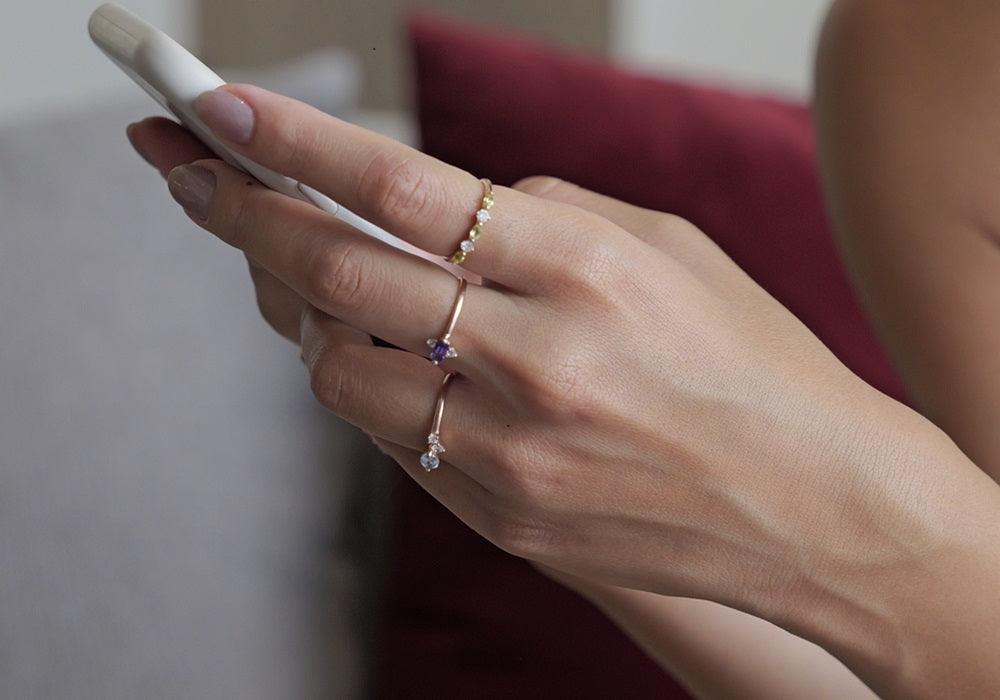JEWELRY KNOWLEDGE, THE BASICS
Gems Varieties
Gemstones come in many varieties, ranging from natural, lab-created, or even imitation.

Natural Gemstones
Natural gemstones are minerals or organic matter used in jewelry after cutting and polishing them. Many jewelers will grade the gemstone based on characteristics like color, clarity, and sparkle. Colored gemstones are often enhanced by heat treatment to improve their color and clarity. This is typically permanent but there are other treatment methods that are not. Thus, it is always important to ask about the quality of the natural gemstone.
Lab-created Gemstones
Lab-created Gemstones often have the same physical qualities and will often look the same as natural gemstones. However, lab-created gemstones do not have the same value and rarity as natural gemstones. If needed a gemologist can help you recognize the often minuscule differences between a natural gemstone and a lab-created gemstone.
Imitation Gemstones
Other materials can be used to create gemstone look-alikes. These can be made with materials such as glass o cubic zirconia to look like a gemstone. However, imitation gemstones do not have the same value and rarity as natural gemstones and can look different from their natural and lab-created counterparts.
Metals
Jewelry is typically made with precious metals like gold and silver. Generally, 14k gold and 18k gold are the preferred metals when it comes to gold. The jewelry knowledge on the main difference between 14k gold and 18k gold is the gold percentage.
14k Gold
14k gold is made of 58.5% gold and 41.5% alloyed metals and thus tends to be harder and more durable than 18k gold, because this is commonly used in detailed rings, such as everyday rings. This type of gold makes a fine choice for people who have an active lifestyle or those who work with their hands.
18k Gold
18k gold is made of 75% gold and 25% alloyed metals, making it more desirable for engagement rings. However, 18-karat gold is only a good investment if you like wearing fine jewelry on special occasions or important events. This type of gold is also less likely to trigger skin irritation such as allergies.

White Gold:
A beautiful silvery-white gleam typically plated in rhodium, another white metal, for an added layer of shine and durability.
Yellow Gold:
A classic and traditional choice that has a warm golden glow.
Rose Gold:
A unique choice that has a metallic pink hue.
Diamond Varieties
Diamonds also come in many varieties. We sell jewelry with natural Diamonds, Lab-grown Diamonds, and Moissanite.

Natural Diamonds
Diamonds mined from various locations around the world are natural diamonds. They are expensive but retain their value better than lab-grown diamonds or moissanite alternatives.
Lab-grown Diamond
Diamonds made in a controlled lab environment are lab-grown diamonds. These diamonds look like earth-mined diamonds, have exactly the same hardness level and durability, and even receive certification through the Gemological Institute of America (GIA) and the International Gemological Institute (IGI). A lab-grown diamond will be cheaper than a natural diamond however this means it is less likely to hold its value compared to a natural diamond.
Moissanite
While occurring in nature as a mineral called silicon carbide it is rare. Moissanite is usually made in a lab instead. Both moissanite and diamonds can both be colorless or have some color to them but moissanite tends to have more brilliance than a diamond. The result is a rainbow-like effect, while diamonds reflect whiter light. However, moissanite is not as hard as diamonds, with a 9.25-9.5 in the hardness scale compared to a diamond’s 10. Moissanite are GRA-certified.

